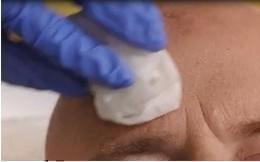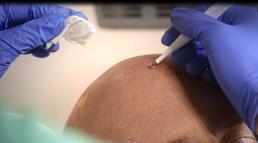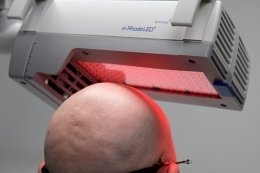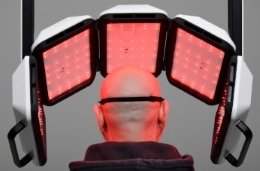Ameluz Gel Dosage
Generic name: AMINOLEVULINIC ACID HYDROCHLORIDE 100mg in 1g
Dosage form: gel
Drug class: Topical photochemotherapeutics
Medically reviewed by Drugs.com. Last updated on Apr 15, 2025.
Important Administration Information
AMELUZ, in conjunction with lesion preparation, is only to be administered by a health care provider.
AMELUZ is for topical use only. Not for ophthalmic, oral, or intravaginal use.
Treat single lesions or an entire field affected by multiple lesions with AMELUZ, in combination with red light photodynamic therapy (PDT). PDT requires administration of both AMELUZ and BF-RhodoLED or RhodoLED XL light.
Refer to BF-RhodoLED or RhodoLED XL user manual for detailed lamp safety and operating instructions. Adhere to all safety instructions for both patient and medical personnel while conducting the PDT.
Recommended Dosage
Apply an approximately 1-mm thick layer of AMELUZ to skin lesion(s). Cover individual lesions or the entire AK-field with AMELUZ. Include approximately 5 mm of the surrounding skin. Do not exceed an application area of 60 cm2. Do not use more than 6 grams of AMELUZ (3 tubes) at one time.
Retreat lesions that have not completely resolved after 3 months after the initial treatment.
Administration Instructions
PDT is a multi-stage process:
Step 1. Preparation of Lesions
Before applying AMELUZ, carefully wipe all lesions with an ethanol or isopropanol-soaked cotton pad to ensure degreasing of the skin.
 Figure 1A: Degreasing the skin
Figure 1A: Degreasing the skin
Thereafter, remove any scaling and crusts and gently roughen all lesion surfaces, taking care to avoid bleeding.
 Figure 1B: Removal of scales and crusts
Figure 1B: Removal of scales and crusts
Step 2. Application of AMELUZ
Apply AMELUZ using glove protected fingertips or a spatula. Use sufficient amount of gel to cover individual lesions or the entire field:
- Lesion-directed treatment: Apply gel approximately 1 mm thick to one or more individual AK lesions and include approximately 5 mm of the surrounding healthy skin.
- Field-directed treatment: Apply gel approximately 1 mm thick to the treatment field. Apply gel to the lesions and the skin in-between the lesions. Additionally, cover approximately 5 mm of the surrounding healthy area.
Do not exceed an application area of 60 cm2 and do not use more than 6 grams of AMELUZ (3 tubes) at one time. The gel can be applied to healthy skin around the lesions. Avoid application near mucous membranes such as the eyes, nostrils, mouth, and ears (keep a distance of 1 cm from these areas). In case of accidental contact with mucous membranes, thoroughly rinse with water.
Allow the gel to dry for approximately 10 minutes before applying occlusive dressing.
 Figure 2: Drug application
Figure 2: Drug application
Step 3. Occlusion for 3 Hours
Cover the area where the gel has been applied with a light-blocking, occlusive dressing. Following 3 hours of occlusion, remove the dressing and wipe off any remaining gel.
 Figure 3: Occlusion
Figure 3: Occlusion
Step 4. Illumination with Red Light
For patient and medical personnel, wear suitable protective eyewear during illumination. Avoid staring directly into the light source.
Illuminate the treatment area with the BF-RhodoLED or RhodoLED XL lamp immediately after removing occlusion and any remaining gel. BF-RhodoLED and RhodoLED XL lamps are red light sources with a narrow spectrum around 635 nm that deliver a light dose of approximately 37 J/cm2. Calibration by the operator is not needed; the illumination time is calculated automatically. Physical measures such as cooling with an air stream or nebulized water may help reduce pain during illumination.
Either the BF-RhodoLED or RhodoLED XL lamp can be used:
- BF-RhodoLED has an effective treatment area of 6 x 16 cm when an area of 8 x 18 cm is illuminated. Position the lamp head 5-8 cm from the skin’s surface. Larger areas can be illuminated in several steps.
- RhodoLED XL has a curved configuration with an effective treatment area up to 23 x 29 cm. Position the lamp head of the RhodoLED XL 11-14 cm from the skin’s surface. This usually allows a full-face illumination with the use of 5 panels. The smallest recommended number of panels to be used are 3 adjacent panels (see chapter 8.4.6 of RhodoLED XL user manual).
Healthy untreated skin surrounding the AK lesions does not need protection during illumination.
 Figure 4A: Illumination with BF-RhodoLED
Figure 4A: Illumination with BF-RhodoLED
 Figure 4B: Illumination with RhodoLED XL
Figure 4B: Illumination with RhodoLED XL
If for any reason, the lesions cannot be illuminated within 3 hours after AMELUZ application, rinse off the gel with saline and water. For 2 days, protect the lesion sites and surrounding skin from sunlight or prolonged or intense light (e.g., tanning beds, sun lamps).
Frequently asked questions
More about Ameluz (aminolevulinic acid topical)
- Check interactions
- Compare alternatives
- Pricing & coupons
- Side effects
- During pregnancy
- FDA approval history
- Drug class: topical photochemotherapeutics
- Breastfeeding
- En español
Patient resources
Other brands
Professional resources
Other brands
Related treatment guides
See also:
Further information
Always consult your healthcare provider to ensure the information displayed on this page applies to your personal circumstances.

